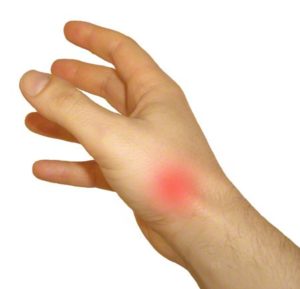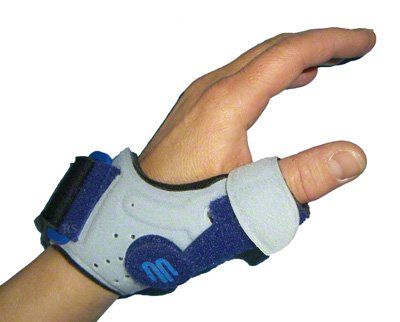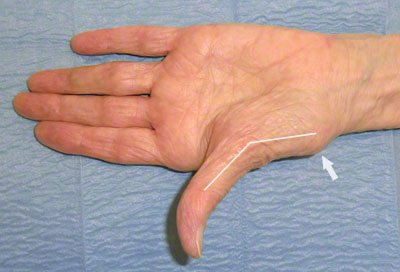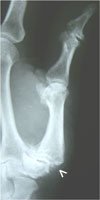Thumb saddle joint arthrosis or rhizarthrosis is the most common arthrosis (wear and tear disease) of the hand. It affects women more often than men. It rarely occurs after fractures involving the joint.
What is special is that some patients at the Yuveo Clinic Düsseldorf who show pronounced osteoarthritis of the thumb saddle joint on X-ray have hardly any symptoms.

Contents
Yuveo Clinic
Special features of rhizarthrosis
What is certainly special is that patients with severe osteoarthritis sometimes have hardly any symptoms, but those with relatively mild rhizarthrosis report severe pain and limitations.
Rhizarthrosis = thumb arthrosis
Conservative treatment
Surgery with a donor tendon
Rhizarthrosis - joint replacement with autologous tissue at Hand Surgery Düsseldorf
The operation for thumb saddle joint arthrosis by joint replacement with autologous tissue (tendon).
The operation can be performed on an outpatient basis (depending on secondary conditions) or as an inpatient procedure. Plexus anesthesia(arm anesthesia in the armpit) is often used. However, there is also the option of so-called iv. Regional anesthesia in combination with twilight sleep.
In rhizarthrosis, the joint surface between the large polygonal bone and the first metacarpal bone is damaged. This joint needs to be removed and reconstructed during the operation. First, the large polygonal bone is removed via an approx. 3-4 cm long incision at the base of the thumb on the extensor side.
Our plastic surgeons protect the ligaments, the nerves that are important for skin sensation and the deeper donor tendon.
The donor tendon comes from the forearm. This creates a good buffer zone for the base of the first metacarpal bone.
The metacarpal bone is fixed to the tendon through a drilled hole.
This tendon is then knotted and this knot is stabilized with additional sutures. As described above, the knot fills the resulting gap.
Frequently asked questions about osteoarthritis of the thumb saddle joint
How does rhizarthrosis develop?
Rhizarthrosis is also known as thumb saddle joint arthrosis, saddle joint arthrosis or, in layman’s terms, simply thumb arthrosis.
Rhizarthrosis is often associated with a hereditary predisposition.
Basic fractures of the 1st metacarpal with joint involvement can also lead to wear of the thumb saddle joint.
On the X-ray, you can see a narrowed joint space, which has completely disappeared in advanced cases. Hand surgeons also refer to this as a bone lump, as the joint no longer has a cartilage layer. The final stage of rhizarthrosis is joint stiffness.
Anatomy:
The thumb saddle joint is located on the wrist at the base of the thumb. If you stretch your thumb, you can recognize two tendons at its base on the stretching side, which tense up. If you then press into the intervening dimple (on the part of the dimple furthest from the body), you can feel the large polygonal bone (a carpal bone), which forms the saddle joint with the first metacarpal bone. The name describes the relationship between the two bones. The first metacarpal bone sits on the polygonal bone like a rider on a saddle.
What are the typical symptoms of thumb arthrosis?
The severity of the pain in rhizarthrosis depends on the stage of the disease.
There is an astonishing degree of individual variability in terms of symptoms. There are patients who come to us for hand surgery in Düsseldorf who hardly feel any pain despite severe osteoarthritis on X-ray and vice versa. The pain in the thumb is usually load-dependent and often weather-dependent (weather sensitivity). Often, so-called activation of rhizarthrosis occurs after heavy use of the thumb, in which our hand surgery team can detect swelling, increased pain and sometimes redness.
Underuse of the thumb leads to atrophy of the thumb muscles, resulting in weakness. The remodeling processes not only affect the muscles, but our Düsseldorf team can also observe them in the bones and ligaments. Bone density decreases, the joint becomes unstable and the first metacarpal bone slips towards the radius. In hand surgery, the latter is known as subluxation, which is common in the context of advanced rhizarthrosis.
How can this osteoarthritis be treated conservatively?
Conservative treatment of osteoarthritis of the thumb saddle joint consists of immobilizing the joint and inhibiting inflammation (inflammation without bacteria!).
Medication
Our Düsseldorf team also applies ointment dressings and prescribes non-steroidal anti-inflammatory drugs ( NSAIDs ).
If necessary, we can also inject anti-inflammatory medication (NSAIDs) into the thumb saddle joint.
Rails
We achieve immobilization with special splints that are fixed with Velcro. They immobilize the metacarpophalangeal and saddle joints. The splints are worn temporarily (at night or during exercise).
What is the follow-up treatment for thumb saddle joint arthrosis after hand surgery in Düsseldorf?
This shows the follow-up treatment after joint replacement with autologous tissue (resection interposition arthroplasty), as performed by Dr. Schumann at the YUVEO Clinic in Düsseldorf. As no metal is used during the operation, the saddle joint does not need to be fixed in a cast for a long time.
What is the treatment of rhizarthrosis after resection arthroplasty?
After resection interposition arthroplasty for rhizarthrosis, a two-week immobilization of the thumb with a thumb plaster splint is standard.
We then remove the stitches and apply a absorbent cotton bandage for a further 2 weeks. With this bandage, careful movement exercises can be carried out without weight-bearing from the third week onwards under supervision. This is to prevent the tendons and ligaments from sticking together. Weight-bearing exercises then begin carefully from the 5th week.
The hand can be expected to be fully functional without restrictions after approx. 2-3 months.
Fact check after joint replacement with autologous tissue
- Practitioners: Dr. Schumann and Dr. Schumann-Averkiou
- Anesthesia: Anesthesia in the armpit, twilight sleep
- Hospitalization: mostly outpatient, also inpatient
- Aftercare: 2 weeks splint, then 2 weeks cotton bandage
- Load build-up: after 3 weeks of careful movement exercises, approximately after 5 weeks of load build-up
- Fully operational: after 2 to 3 months
Related topics and further information
Technical terms:
- Carpometacarpal joint arthrosis = rhizarthrosis = thumb arthrosis
- Musculus flexor carpi radialis = forearm muscle, where the donor tendon for the operation is obtained.
- Os trapezium = polygonal bone of the thumb
Related topics:
Further information:







